Importance of Communication in Personal and Professional Life
VerifiedAdded on 2023/06/05
|8
|2007
|307
AI Summary
This essay highlights the importance of Communication in personal and professional life. It covers various forms of communication, theories, non-verbal communication, business writing, academic writing, literature review, public speaking, organizational communication, interpersonal communication, and intercultural communication.
Contribute Materials
Your contribution can guide someone’s learning journey. Share your
documents today.
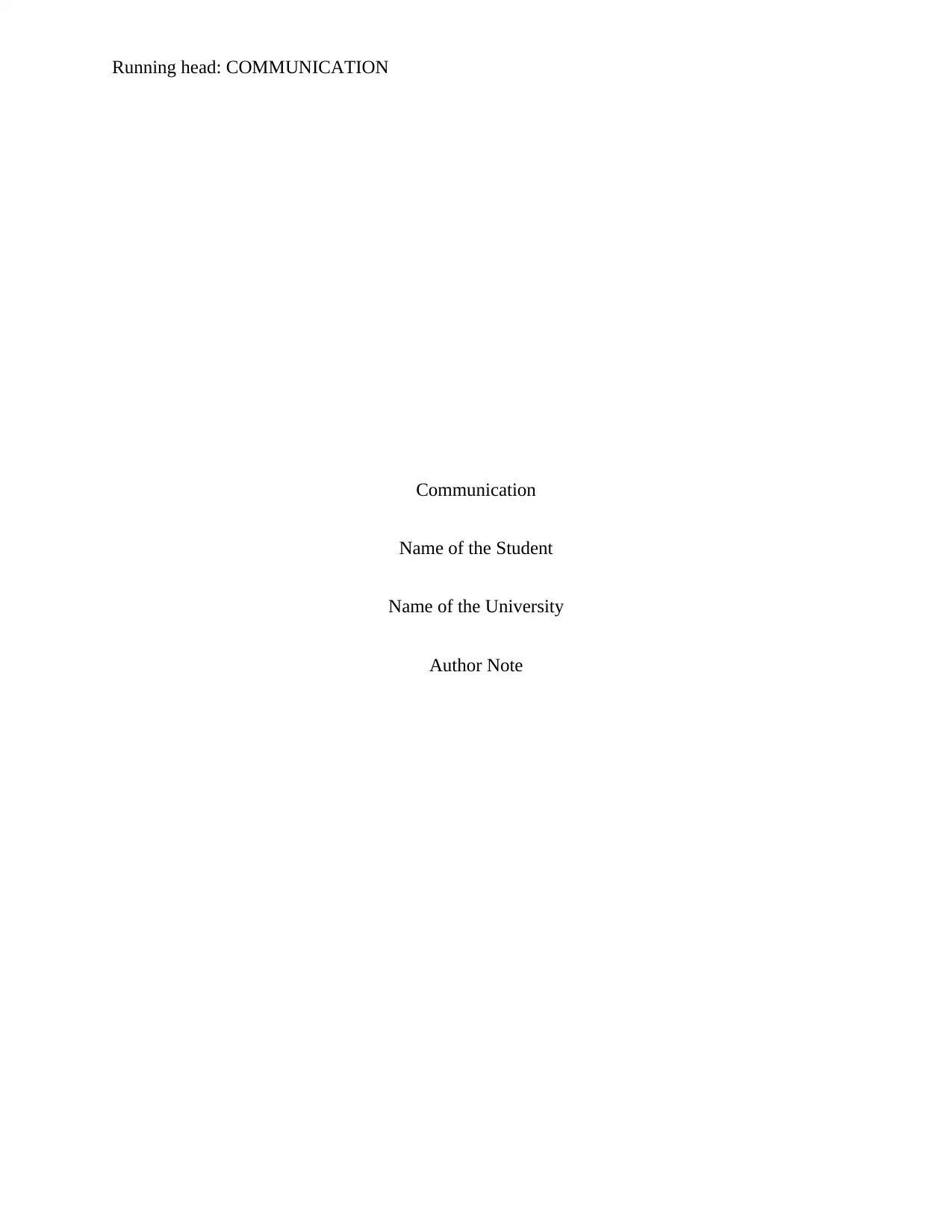
Running head: COMMUNICATION
Communication
Name of the Student
Name of the University
Author Note
Communication
Name of the Student
Name of the University
Author Note
Secure Best Marks with AI Grader
Need help grading? Try our AI Grader for instant feedback on your assignments.
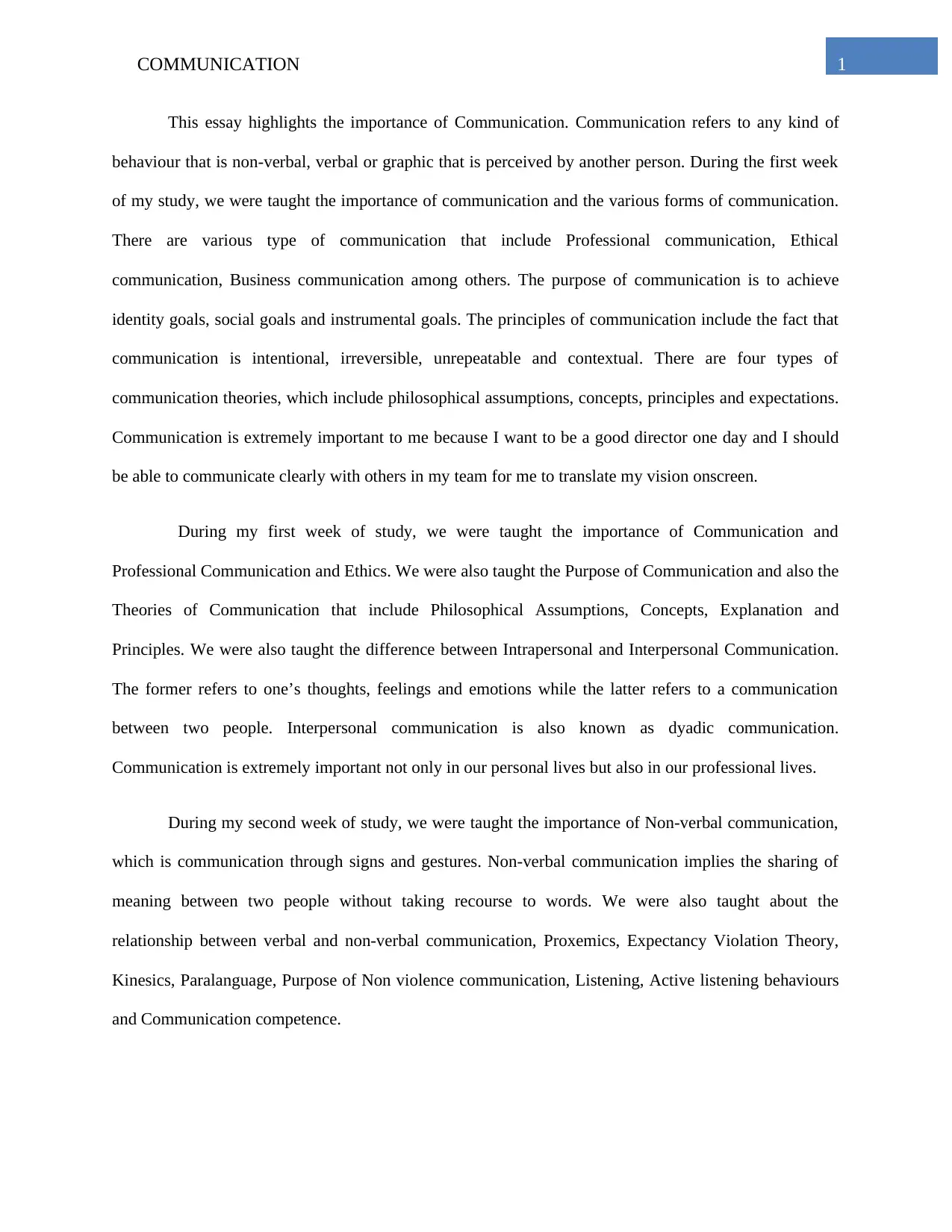
1COMMUNICATION
This essay highlights the importance of Communication. Communication refers to any kind of
behaviour that is non-verbal, verbal or graphic that is perceived by another person. During the first week
of my study, we were taught the importance of communication and the various forms of communication.
There are various type of communication that include Professional communication, Ethical
communication, Business communication among others. The purpose of communication is to achieve
identity goals, social goals and instrumental goals. The principles of communication include the fact that
communication is intentional, irreversible, unrepeatable and contextual. There are four types of
communication theories, which include philosophical assumptions, concepts, principles and expectations.
Communication is extremely important to me because I want to be a good director one day and I should
be able to communicate clearly with others in my team for me to translate my vision onscreen.
During my first week of study, we were taught the importance of Communication and
Professional Communication and Ethics. We were also taught the Purpose of Communication and also the
Theories of Communication that include Philosophical Assumptions, Concepts, Explanation and
Principles. We were also taught the difference between Intrapersonal and Interpersonal Communication.
The former refers to one’s thoughts, feelings and emotions while the latter refers to a communication
between two people. Interpersonal communication is also known as dyadic communication.
Communication is extremely important not only in our personal lives but also in our professional lives.
During my second week of study, we were taught the importance of Non-verbal communication,
which is communication through signs and gestures. Non-verbal communication implies the sharing of
meaning between two people without taking recourse to words. We were also taught about the
relationship between verbal and non-verbal communication, Proxemics, Expectancy Violation Theory,
Kinesics, Paralanguage, Purpose of Non violence communication, Listening, Active listening behaviours
and Communication competence.
This essay highlights the importance of Communication. Communication refers to any kind of
behaviour that is non-verbal, verbal or graphic that is perceived by another person. During the first week
of my study, we were taught the importance of communication and the various forms of communication.
There are various type of communication that include Professional communication, Ethical
communication, Business communication among others. The purpose of communication is to achieve
identity goals, social goals and instrumental goals. The principles of communication include the fact that
communication is intentional, irreversible, unrepeatable and contextual. There are four types of
communication theories, which include philosophical assumptions, concepts, principles and expectations.
Communication is extremely important to me because I want to be a good director one day and I should
be able to communicate clearly with others in my team for me to translate my vision onscreen.
During my first week of study, we were taught the importance of Communication and
Professional Communication and Ethics. We were also taught the Purpose of Communication and also the
Theories of Communication that include Philosophical Assumptions, Concepts, Explanation and
Principles. We were also taught the difference between Intrapersonal and Interpersonal Communication.
The former refers to one’s thoughts, feelings and emotions while the latter refers to a communication
between two people. Interpersonal communication is also known as dyadic communication.
Communication is extremely important not only in our personal lives but also in our professional lives.
During my second week of study, we were taught the importance of Non-verbal communication,
which is communication through signs and gestures. Non-verbal communication implies the sharing of
meaning between two people without taking recourse to words. We were also taught about the
relationship between verbal and non-verbal communication, Proxemics, Expectancy Violation Theory,
Kinesics, Paralanguage, Purpose of Non violence communication, Listening, Active listening behaviours
and Communication competence.
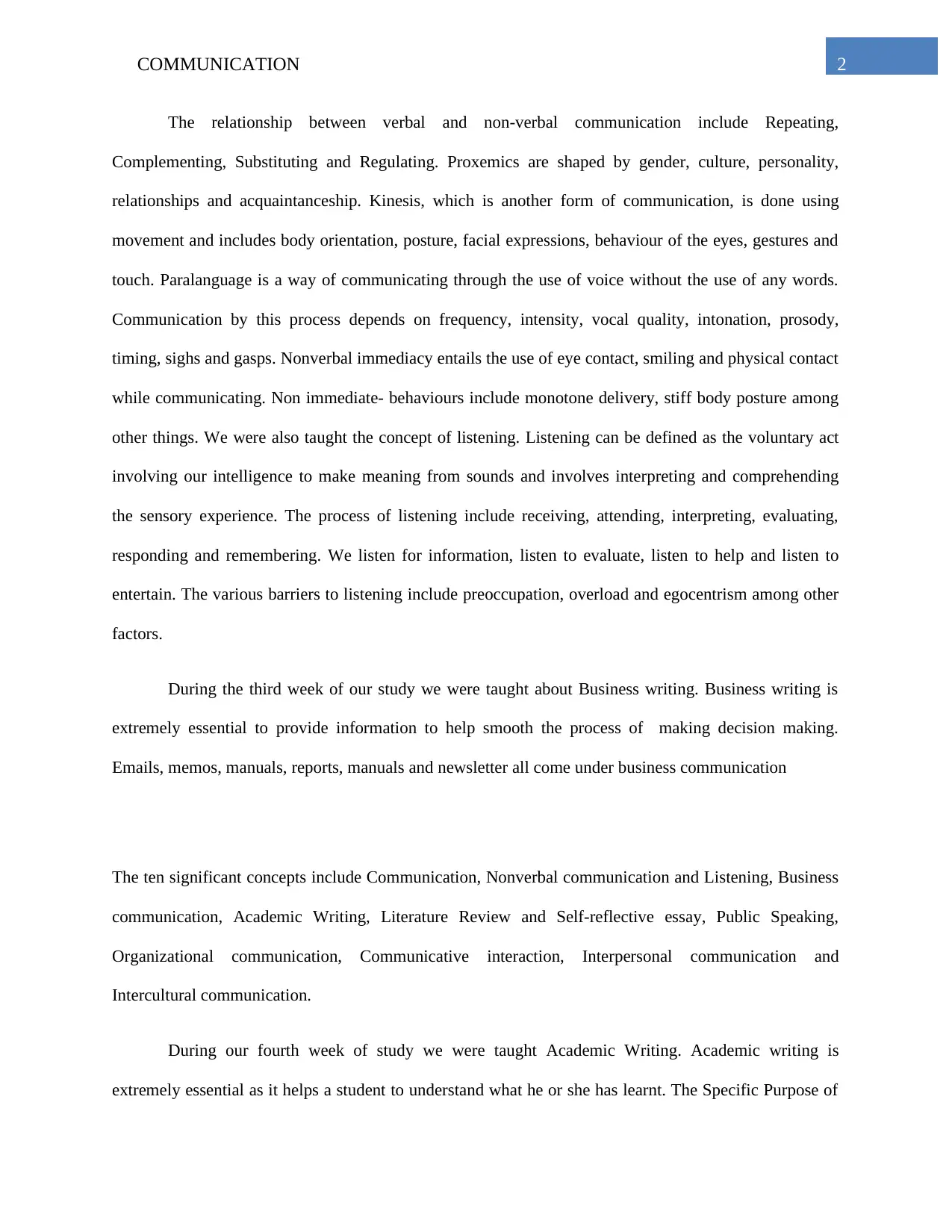
2COMMUNICATION
The relationship between verbal and non-verbal communication include Repeating,
Complementing, Substituting and Regulating. Proxemics are shaped by gender, culture, personality,
relationships and acquaintanceship. Kinesis, which is another form of communication, is done using
movement and includes body orientation, posture, facial expressions, behaviour of the eyes, gestures and
touch. Paralanguage is a way of communicating through the use of voice without the use of any words.
Communication by this process depends on frequency, intensity, vocal quality, intonation, prosody,
timing, sighs and gasps. Nonverbal immediacy entails the use of eye contact, smiling and physical contact
while communicating. Non immediate- behaviours include monotone delivery, stiff body posture among
other things. We were also taught the concept of listening. Listening can be defined as the voluntary act
involving our intelligence to make meaning from sounds and involves interpreting and comprehending
the sensory experience. The process of listening include receiving, attending, interpreting, evaluating,
responding and remembering. We listen for information, listen to evaluate, listen to help and listen to
entertain. The various barriers to listening include preoccupation, overload and egocentrism among other
factors.
During the third week of our study we were taught about Business writing. Business writing is
extremely essential to provide information to help smooth the process of making decision making.
Emails, memos, manuals, reports, manuals and newsletter all come under business communication
The ten significant concepts include Communication, Nonverbal communication and Listening, Business
communication, Academic Writing, Literature Review and Self-reflective essay, Public Speaking,
Organizational communication, Communicative interaction, Interpersonal communication and
Intercultural communication.
During our fourth week of study we were taught Academic Writing. Academic writing is
extremely essential as it helps a student to understand what he or she has learnt. The Specific Purpose of
The relationship between verbal and non-verbal communication include Repeating,
Complementing, Substituting and Regulating. Proxemics are shaped by gender, culture, personality,
relationships and acquaintanceship. Kinesis, which is another form of communication, is done using
movement and includes body orientation, posture, facial expressions, behaviour of the eyes, gestures and
touch. Paralanguage is a way of communicating through the use of voice without the use of any words.
Communication by this process depends on frequency, intensity, vocal quality, intonation, prosody,
timing, sighs and gasps. Nonverbal immediacy entails the use of eye contact, smiling and physical contact
while communicating. Non immediate- behaviours include monotone delivery, stiff body posture among
other things. We were also taught the concept of listening. Listening can be defined as the voluntary act
involving our intelligence to make meaning from sounds and involves interpreting and comprehending
the sensory experience. The process of listening include receiving, attending, interpreting, evaluating,
responding and remembering. We listen for information, listen to evaluate, listen to help and listen to
entertain. The various barriers to listening include preoccupation, overload and egocentrism among other
factors.
During the third week of our study we were taught about Business writing. Business writing is
extremely essential to provide information to help smooth the process of making decision making.
Emails, memos, manuals, reports, manuals and newsletter all come under business communication
The ten significant concepts include Communication, Nonverbal communication and Listening, Business
communication, Academic Writing, Literature Review and Self-reflective essay, Public Speaking,
Organizational communication, Communicative interaction, Interpersonal communication and
Intercultural communication.
During our fourth week of study we were taught Academic Writing. Academic writing is
extremely essential as it helps a student to understand what he or she has learnt. The Specific Purpose of

3COMMUNICATION
Academic writing include is to recognize, acknowledge, appreciate and evaluate the accumulated
knowledge of a specific topic. The general purpose of Academic Writing is to demonstrate the mastery of
a student’s knowledge on a given topic. The basic principles of academic writing were also taught to us
such as active voice and passive voice, the importance of an introductory paragraph, body paragraphs and
concluding paragraphs, the importance of Referencing and In-Text citations and the procedure for doing
the same.
During our fifth week of study we were taught the how to write a Literature Review and a Self-
reflective essay. Literature review solves the purpose of demonstrating one’s knowledge of what is known
already about a specific field of knowledge. Literature review establishes the importance and the
background context of a pertinent issue. A literature review should analyze, identify and interpret existing
information. We were also taught the structure of a literature review. We were also taught about reflective
writing and the structure of reflective writing. Reflective writing involves an essay structure comprising
of an Introduction, Body and Conclusion. Reflective writing is descriptive in nature. It also involves
analysis and critical evaluation.
During our sixth week of study, we were taught the various approaches to public speaking. We
were also enlightened about the various types of speaking which include impromptu, extemporaneous,
verbatim from a manuscript, verbatim from memory. We were taught the concept of communication
apprehension and how to overcome communication anxiety. We were taught the structure of a
presentation. All presentations have an introduction, body and conclusion. There are various types of
presentations. They are briefings, trainings, reports, proposals and sales presentation, explanations,
welcoming remarks, introducing another speaker, honouring a person or an institution and presenting and
accepting an award. We were also taught on how to write a proposal, sales presentation and a training
presentation.
Academic writing include is to recognize, acknowledge, appreciate and evaluate the accumulated
knowledge of a specific topic. The general purpose of Academic Writing is to demonstrate the mastery of
a student’s knowledge on a given topic. The basic principles of academic writing were also taught to us
such as active voice and passive voice, the importance of an introductory paragraph, body paragraphs and
concluding paragraphs, the importance of Referencing and In-Text citations and the procedure for doing
the same.
During our fifth week of study we were taught the how to write a Literature Review and a Self-
reflective essay. Literature review solves the purpose of demonstrating one’s knowledge of what is known
already about a specific field of knowledge. Literature review establishes the importance and the
background context of a pertinent issue. A literature review should analyze, identify and interpret existing
information. We were also taught the structure of a literature review. We were also taught about reflective
writing and the structure of reflective writing. Reflective writing involves an essay structure comprising
of an Introduction, Body and Conclusion. Reflective writing is descriptive in nature. It also involves
analysis and critical evaluation.
During our sixth week of study, we were taught the various approaches to public speaking. We
were also enlightened about the various types of speaking which include impromptu, extemporaneous,
verbatim from a manuscript, verbatim from memory. We were taught the concept of communication
apprehension and how to overcome communication anxiety. We were taught the structure of a
presentation. All presentations have an introduction, body and conclusion. There are various types of
presentations. They are briefings, trainings, reports, proposals and sales presentation, explanations,
welcoming remarks, introducing another speaker, honouring a person or an institution and presenting and
accepting an award. We were also taught on how to write a proposal, sales presentation and a training
presentation.
Secure Best Marks with AI Grader
Need help grading? Try our AI Grader for instant feedback on your assignments.
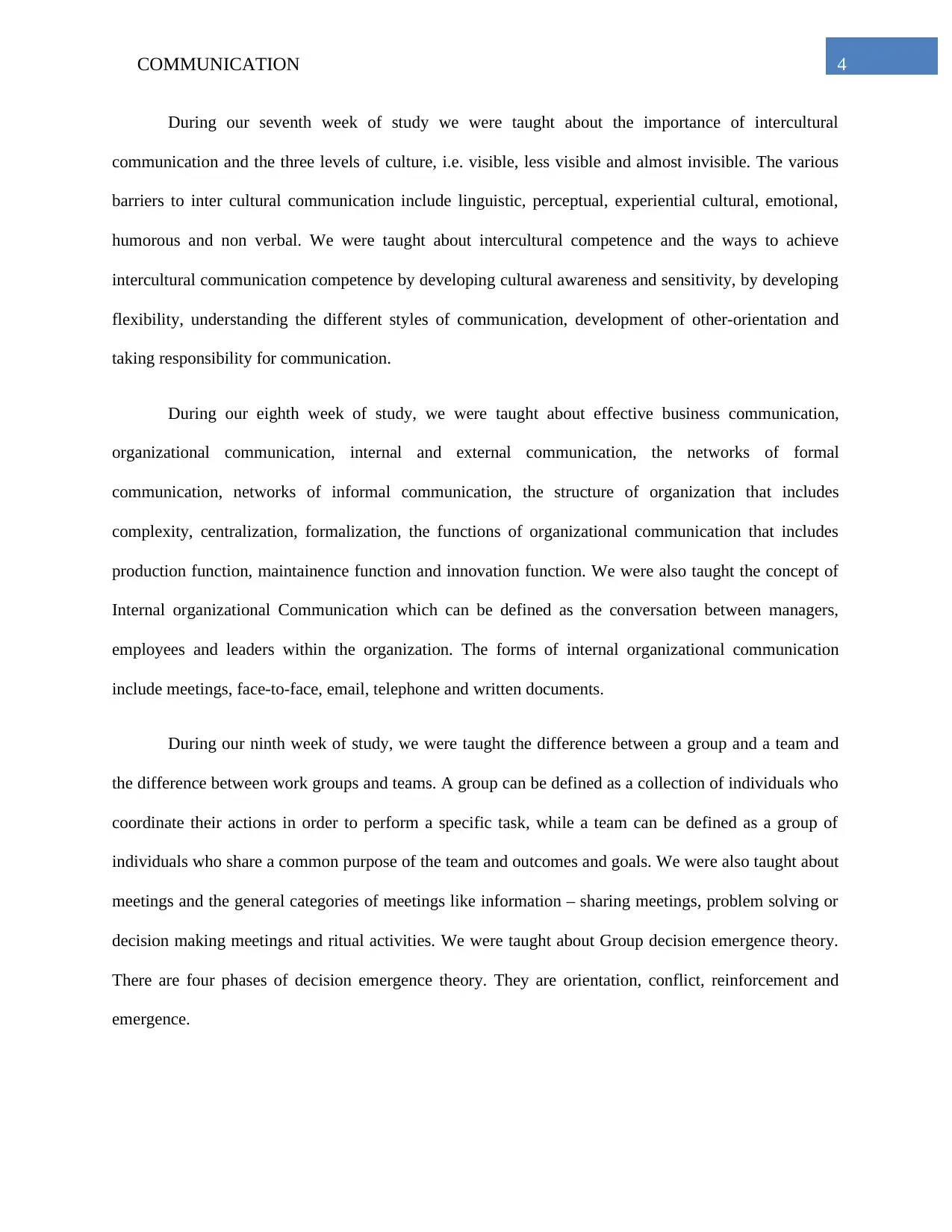
4COMMUNICATION
During our seventh week of study we were taught about the importance of intercultural
communication and the three levels of culture, i.e. visible, less visible and almost invisible. The various
barriers to inter cultural communication include linguistic, perceptual, experiential cultural, emotional,
humorous and non verbal. We were taught about intercultural competence and the ways to achieve
intercultural communication competence by developing cultural awareness and sensitivity, by developing
flexibility, understanding the different styles of communication, development of other-orientation and
taking responsibility for communication.
During our eighth week of study, we were taught about effective business communication,
organizational communication, internal and external communication, the networks of formal
communication, networks of informal communication, the structure of organization that includes
complexity, centralization, formalization, the functions of organizational communication that includes
production function, maintainence function and innovation function. We were also taught the concept of
Internal organizational Communication which can be defined as the conversation between managers,
employees and leaders within the organization. The forms of internal organizational communication
include meetings, face-to-face, email, telephone and written documents.
During our ninth week of study, we were taught the difference between a group and a team and
the difference between work groups and teams. A group can be defined as a collection of individuals who
coordinate their actions in order to perform a specific task, while a team can be defined as a group of
individuals who share a common purpose of the team and outcomes and goals. We were also taught about
meetings and the general categories of meetings like information – sharing meetings, problem solving or
decision making meetings and ritual activities. We were taught about Group decision emergence theory.
There are four phases of decision emergence theory. They are orientation, conflict, reinforcement and
emergence.
During our seventh week of study we were taught about the importance of intercultural
communication and the three levels of culture, i.e. visible, less visible and almost invisible. The various
barriers to inter cultural communication include linguistic, perceptual, experiential cultural, emotional,
humorous and non verbal. We were taught about intercultural competence and the ways to achieve
intercultural communication competence by developing cultural awareness and sensitivity, by developing
flexibility, understanding the different styles of communication, development of other-orientation and
taking responsibility for communication.
During our eighth week of study, we were taught about effective business communication,
organizational communication, internal and external communication, the networks of formal
communication, networks of informal communication, the structure of organization that includes
complexity, centralization, formalization, the functions of organizational communication that includes
production function, maintainence function and innovation function. We were also taught the concept of
Internal organizational Communication which can be defined as the conversation between managers,
employees and leaders within the organization. The forms of internal organizational communication
include meetings, face-to-face, email, telephone and written documents.
During our ninth week of study, we were taught the difference between a group and a team and
the difference between work groups and teams. A group can be defined as a collection of individuals who
coordinate their actions in order to perform a specific task, while a team can be defined as a group of
individuals who share a common purpose of the team and outcomes and goals. We were also taught about
meetings and the general categories of meetings like information – sharing meetings, problem solving or
decision making meetings and ritual activities. We were taught about Group decision emergence theory.
There are four phases of decision emergence theory. They are orientation, conflict, reinforcement and
emergence.

5COMMUNICATION
During our tenth week of study, we were taught about Interpersonal Communication which can
be defined as communicating with others. We were also taught to recognize the difference between
intrapersonal and interpersonal communication. We were also taught the concept of aggressive
communication and were taught to identify the various types of verbally aggressive messages.
Academic listening involves the listening and perceiving the spoken material with the purpose of
education (Berger, 2014). Academic listening has numerous forms and includes academic lectures,
debates and seminar conversations among others. There are two types of listening (McNair, 2017). They
are Discriminative listening and Comprehensive listening. The three main types of listening that is most
important in interpersonal communication include Informational Listening, ie. when a person listens to
learn something, Critical Listening i.e. when a person listens in order to evaluate and analyze and
Therapeutic or Empathetic Listening i.e. when a person listens in order to understand feelings and
emotion (McNair, 2017).
Since I would like to become a film director, the two concepts that would help me in my chosen
field include Communication and Listening. Since I will be working in a team I need to be able to
communicate with my cast and crew in order to make them understand my vision and be able to translate
my vision on screen. I should also be able to listen to my team members and encourage positive feedback
and constructive criticism from them.
Thus communication is extremely important. It is an integral part of our lives and human beings
need to communicate with one another as they cannot live in isolation. One should be able to
communicate in a clear concise manner for others to understand what he or she is saying.
During our tenth week of study, we were taught about Interpersonal Communication which can
be defined as communicating with others. We were also taught to recognize the difference between
intrapersonal and interpersonal communication. We were also taught the concept of aggressive
communication and were taught to identify the various types of verbally aggressive messages.
Academic listening involves the listening and perceiving the spoken material with the purpose of
education (Berger, 2014). Academic listening has numerous forms and includes academic lectures,
debates and seminar conversations among others. There are two types of listening (McNair, 2017). They
are Discriminative listening and Comprehensive listening. The three main types of listening that is most
important in interpersonal communication include Informational Listening, ie. when a person listens to
learn something, Critical Listening i.e. when a person listens in order to evaluate and analyze and
Therapeutic or Empathetic Listening i.e. when a person listens in order to understand feelings and
emotion (McNair, 2017).
Since I would like to become a film director, the two concepts that would help me in my chosen
field include Communication and Listening. Since I will be working in a team I need to be able to
communicate with my cast and crew in order to make them understand my vision and be able to translate
my vision on screen. I should also be able to listen to my team members and encourage positive feedback
and constructive criticism from them.
Thus communication is extremely important. It is an integral part of our lives and human beings
need to communicate with one another as they cannot live in isolation. One should be able to
communicate in a clear concise manner for others to understand what he or she is saying.
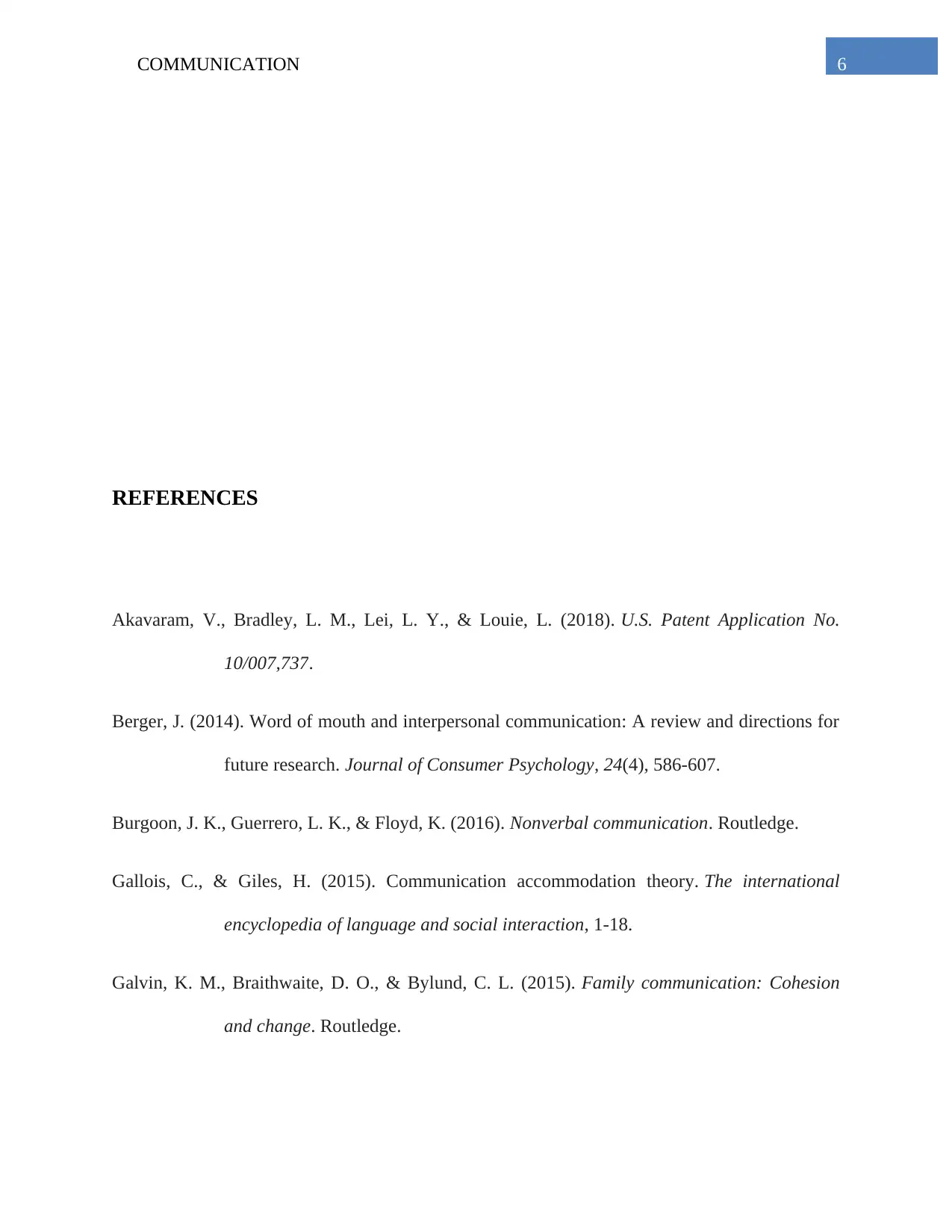
6COMMUNICATION
REFERENCES
Akavaram, V., Bradley, L. M., Lei, L. Y., & Louie, L. (2018). U.S. Patent Application No.
10/007,737.
Berger, J. (2014). Word of mouth and interpersonal communication: A review and directions for
future research. Journal of Consumer Psychology, 24(4), 586-607.
Burgoon, J. K., Guerrero, L. K., & Floyd, K. (2016). Nonverbal communication. Routledge.
Gallois, C., & Giles, H. (2015). Communication accommodation theory. The international
encyclopedia of language and social interaction, 1-18.
Galvin, K. M., Braithwaite, D. O., & Bylund, C. L. (2015). Family communication: Cohesion
and change. Routledge.
REFERENCES
Akavaram, V., Bradley, L. M., Lei, L. Y., & Louie, L. (2018). U.S. Patent Application No.
10/007,737.
Berger, J. (2014). Word of mouth and interpersonal communication: A review and directions for
future research. Journal of Consumer Psychology, 24(4), 586-607.
Burgoon, J. K., Guerrero, L. K., & Floyd, K. (2016). Nonverbal communication. Routledge.
Gallois, C., & Giles, H. (2015). Communication accommodation theory. The international
encyclopedia of language and social interaction, 1-18.
Galvin, K. M., Braithwaite, D. O., & Bylund, C. L. (2015). Family communication: Cohesion
and change. Routledge.
Paraphrase This Document
Need a fresh take? Get an instant paraphrase of this document with our AI Paraphraser
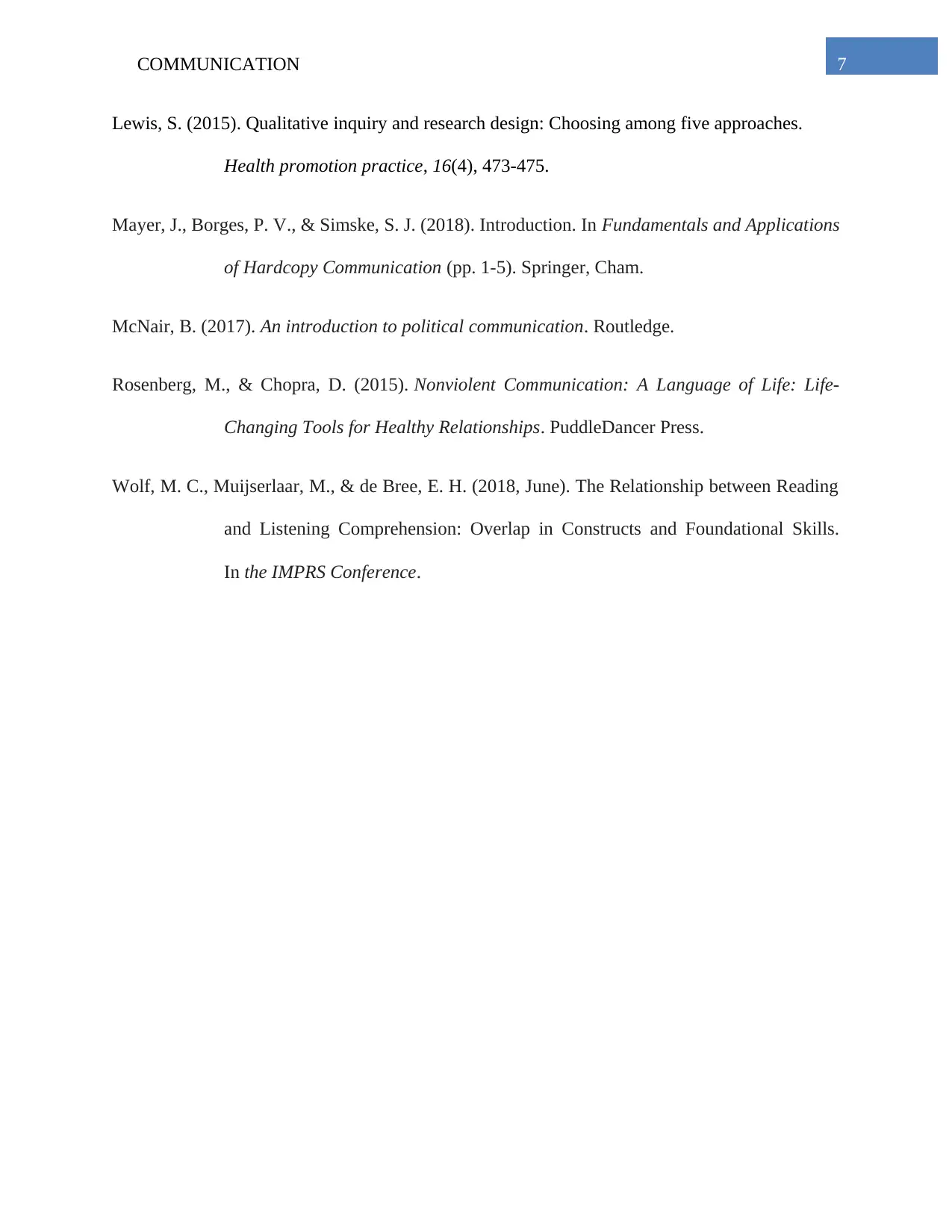
7COMMUNICATION
Lewis, S. (2015). Qualitative inquiry and research design: Choosing among five approaches.
Health promotion practice, 16(4), 473-475.
Mayer, J., Borges, P. V., & Simske, S. J. (2018). Introduction. In Fundamentals and Applications
of Hardcopy Communication (pp. 1-5). Springer, Cham.
McNair, B. (2017). An introduction to political communication. Routledge.
Rosenberg, M., & Chopra, D. (2015). Nonviolent Communication: A Language of Life: Life-
Changing Tools for Healthy Relationships. PuddleDancer Press.
Wolf, M. C., Muijserlaar, M., & de Bree, E. H. (2018, June). The Relationship between Reading
and Listening Comprehension: Overlap in Constructs and Foundational Skills.
In the IMPRS Conference.
Lewis, S. (2015). Qualitative inquiry and research design: Choosing among five approaches.
Health promotion practice, 16(4), 473-475.
Mayer, J., Borges, P. V., & Simske, S. J. (2018). Introduction. In Fundamentals and Applications
of Hardcopy Communication (pp. 1-5). Springer, Cham.
McNair, B. (2017). An introduction to political communication. Routledge.
Rosenberg, M., & Chopra, D. (2015). Nonviolent Communication: A Language of Life: Life-
Changing Tools for Healthy Relationships. PuddleDancer Press.
Wolf, M. C., Muijserlaar, M., & de Bree, E. H. (2018, June). The Relationship between Reading
and Listening Comprehension: Overlap in Constructs and Foundational Skills.
In the IMPRS Conference.
1 out of 8
Related Documents
Your All-in-One AI-Powered Toolkit for Academic Success.
+13062052269
info@desklib.com
Available 24*7 on WhatsApp / Email
![[object Object]](/_next/static/media/star-bottom.7253800d.svg)
Unlock your academic potential
© 2024 | Zucol Services PVT LTD | All rights reserved.





